Chariots of the Gods?
Among the various conspiracy theories of the 1960s, one of the most popular – and most fanciful – was a book, and later a movie, titled “Chariots of the Gods” by Erich Von Daniken, which made pseudo-scientific claims about extraterrestrial influences on early human cultures. One of the most intriguing segments involved the so-called “Nazca Lines,” a collection of hundreds of enormous geoglyphs in the high desert of Peru, representing birds, animals, insects, mythical figures, trees and flowers.
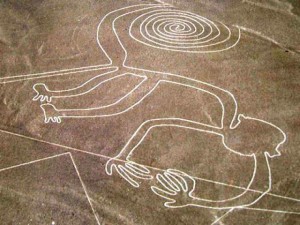
According to Von Daniken, the designs can only be seen from the air, but in reality, they are visible from the surrounding foothills. Although they don’t agree with Von Daniken’s claims that the Nazca Lines were designed as airstrips or landing instructions for visitors from other worlds, most scientists do agree that they had a great deal of cosmological and religious significance for the people who created them. The Nazca Lines have been studied by many American and international scientists from a variety of disciplines, and have been recognized as a UNESCO World Heritage Site since 1994.
California’s “Nazca Lines” Revealed!
Until a few months ago, Chelle and I thought the Nazca Lines were unique, and since they are in a remote area of Peru, we assumed we would never see anything like them. Imagine our surprise when we “discovered” that right here, in an area stretching from southern Nevada to the Gulf of California, running along both sides of the Colorado River in the California and Arizona deserts, there lies a huge area covered with enormous geoglyphs!
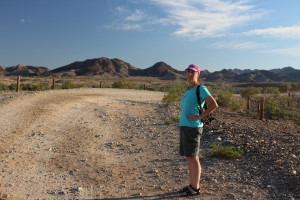
Like the Nazca Lines, they were created by removing a layer of dark pebbles to reveal a lighter surface below, and they appear to have taken significant planning and effort. Also like the Nazca Lines, it is difficult to determine their age or their purpose, but most evidence suggests they held at least religious, if not cosmological significance, for their creators.
Unlike the Nazca Lines, however, these American geoglyphs have received little attention or study from the scientific community, and even less from the general public. They don’t even have a single designation, going by various local names.
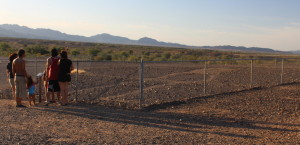
Many are in remote areas, but we found one of the most impressive groups of giant desert figures, known as “The Blythe Intaglios,” was right in the path of our 14th cross-country trip – we were hooked!
The Intaglios: Where? How? What?
Where?
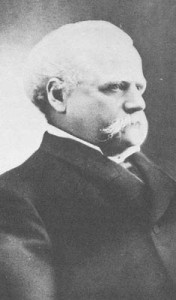
Blythe is a town on the eastern border of Southern California, along the Colorado River, across from Arizona. Named after Henry Blythe, an Englishman who staked a claim to the water from the Colorado River in 1875 in hopes of establishing an agrarian “empire,” Blythe is now best known as a stopover for travelers and campers between Los Angeles and Phoenix. We made our first stop of this trip at Mayflower County Park, right on the Colorado River, unhitched our little red car in 101 degree heat (!), and headed 17 miles north along US 95 to find the mysterious Blythe Intaglios.
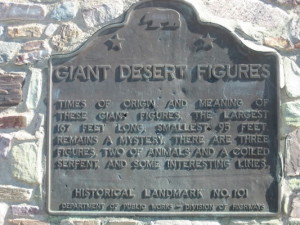
We had learned that California Historical Marker 101 had been placed along the highway many years ago, but it could be easy to miss, so we made sure we got directions to the exact spot from Google maps before we left. When we arrived, we found the Historical Marker was missing!
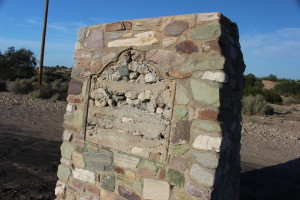
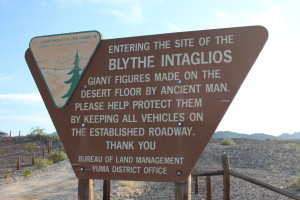
Is this part of the plan for protecting the geoglyphs? The Bureau of Land Management, which oversees the site all the way from Yuma Arizona, doesn’t say. Their website doesn’t offer much information either, and as it says, there are “no amenities” onsite, aside from the hurricane fences that have been placed around each of the intaglios for protection. BLM did place a few signs at the entrance to the site, and descriptions at each of the fenced areas, so you can learn a little about what they might represent while you’re there. There’s not much background about the intaglios onsite, however, so we did some research to help fill in the back story behind these unusual works of art… just for you!

How?

“Intaglio” is a family of printing, printmaking, and artwork techniques in which the image is cut or carved into a flat surface, and the incised or sunken area holds the ink. It’s the opposite of a relief print. Petroglyphs were created using similar techniques, removing the thin dark layer of “desert varnish” often found covering rocks in arid climates. The Blythe Intaglios are in an area where the ground is covered with desert-varnished pebbles over a lighter surface. By removing the darker “varnished” pebbles in carefully planned patterns to expose the lighter surface below, these artists created delicate, enormous images, seemingly aimed toward viewers in the sky. The removed pebbles were then heaped along the edges to further accentuate the glyphs.
What?
The largest image we saw represents a human figure over 100 feet tall, with outstretched arms spanning nearly 65 feet! Although he is primarily a “stick figure,” he possesses what appears to be a phallus, making him at least somewhat anatomically correct, and definitely male.  Nearby, but facing in a different direction, a huge four-legged animal appears to stand close to what may be a coiled snake, presumably keeping a safe distance. What kind of four-legged animal is it? Circles at the end of each leg could be hooves, leading to speculation that the animal is a horse… but horses disappeared from North America at least 10,000 years before they were reintroduced here by the Spaniards in the 16th century, and these figures are thought to be hundreds of years older than that.
Nearby, but facing in a different direction, a huge four-legged animal appears to stand close to what may be a coiled snake, presumably keeping a safe distance. What kind of four-legged animal is it? Circles at the end of each leg could be hooves, leading to speculation that the animal is a horse… but horses disappeared from North America at least 10,000 years before they were reintroduced here by the Spaniards in the 16th century, and these figures are thought to be hundreds of years older than that.
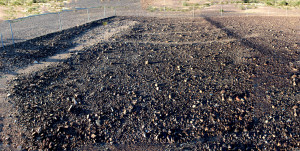
This has given rise to the theory that some horses may have survived the mass extinction, or possibly had been brought to the southwest before Columbus arrived. One theory goes so far as to claim this as “definitive proof” that the Vikings must have delivered the ancestors of the mysterious “horse” depicted in this intaglio!
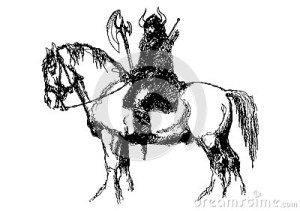
No explanation is offered for what the Vikings were doing in the southwestern desert however, or how they got here. So perhaps this really isn’t a horse after all… what do you think?
Intaglios: When? Who? Why?
When were they discovered”?
 Aside from the indigenous people who created them, the Blythe Intaglios were first noticed by an Army Air Corps pilot named George Palmer who was flying over the desert between the Maria Mountains and the Colorado River in November 1931. Palmer described giant human and animal shapes: “Near two of the human shapes are figures of serpents and four-legged animals with long tails. One giant, or god, appears just to have stepped out of a large dance ring.” He told a curator about them at the Natural History Museum of Los Angeles, who asked Palmer to take aerial photographs. This led to a survey of the area, and the Intaglios were classified as Historical Landmark No. 101, which referred to them as the “Giant Desert Figures.” At that point, the curator, Arthur Woodward, estimated the giant glyphs to be at least 200 years old.
Aside from the indigenous people who created them, the Blythe Intaglios were first noticed by an Army Air Corps pilot named George Palmer who was flying over the desert between the Maria Mountains and the Colorado River in November 1931. Palmer described giant human and animal shapes: “Near two of the human shapes are figures of serpents and four-legged animals with long tails. One giant, or god, appears just to have stepped out of a large dance ring.” He told a curator about them at the Natural History Museum of Los Angeles, who asked Palmer to take aerial photographs. This led to a survey of the area, and the Intaglios were classified as Historical Landmark No. 101, which referred to them as the “Giant Desert Figures.” At that point, the curator, Arthur Woodward, estimated the giant glyphs to be at least 200 years old.
When were they created?
It is very difficult to date geoglyphs with any precision. Carbon-14 dating only works on organic materials like trees, bones, and fossils that have not completely petrified. Other methods based on geological data are also of limited use, so scientists from UC Berkeley used a cross-disciplinary approach to better estimate the age of the “giant desert figures” as dating from 900 AD, nearly a full millennium older than Woodward’s estimate.
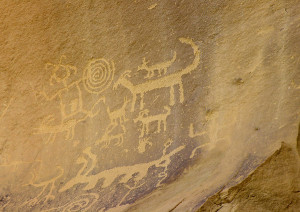
Some of the giant figures have been linked with cliff dwelling, which was common throughout the southwestern United States at that time, and could even go back as far as 2000 years. Now, that’s not exactly pinpointing the age of the Intaglios – somewhere between 1100 and 2000 years old – but it definitely means they pre-date the arrival of Columbus and any other Europeans by a wide margin.
Who?
Most of the indigenous peoples of the southwest have lived there for a very long time, and it’s most likely that their ancestors were the people responsible for creating the intaglios.
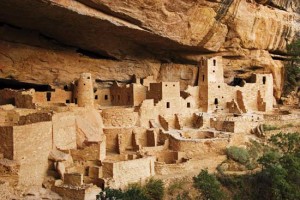
Between 900 AD and 1300 AD, the ancestors of today’s Pueblo tribes built multi-story dwellings, much like modern apartment buildings, into the sides of the many steep cliffs found throughout the southwest and often chipped symbols and images into the desert varnish covering some of the rock faces near their dwellings. Amazingly, the people who solved the complexities of creating the intaglios had not yet invented the wheel, and lived every day in what is now a harsh environment, constantly facing serious challenges in meeting their own basic needs, and only had access to primitive, stone-age tools. That begs the question: why did these people devote so much time and energy to create these huge artworks?
Why?
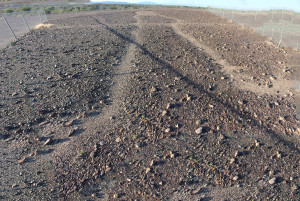
Oral history and traditional beliefs and practices continue to be at the center of Pueblo life today, and it’s highly likely that the same was true for the people who created the giant artworks at Blythe and other areas. According to the nearby Mojave and Quechan tribes, Mastamho, the Creator of Heaven and Earth, decided to create the Colorado River in order to bring water to the desert and the people who lived there.

Hutakulya was one of two mountain lion-persons who assisted Mastamho, and may be the four-legged animal seen near the giant human figure, who is probably Mastamho. In one creation myth, Mastamho plots the death of Sky-Rattlesnake, an evil spirit with dark powers, by cutting off his head before turning himself into a fish-eagle and flying off into oblivion. The spiral glyph beneath the four-legged animal could represent Sky-Rattlesnake. but

spirals also indicate places where “the people,” as most tribes referred to themselves, emerged into this world, often from a world below. Sacred ceremonial dances took place there, honoring Mastamho and some of the rings where people danced were still visible when the intaglios were first “discovered.” They were part of a pilgrimage between the Place of Creation and the Land of Death, and shamans claimed to receive their power from Mastamho through dreams. During the pilgrimages, the shaman would instruct the pilgrims in mythic history and re-enact events from these stories, including the creation of the world, while they beseeched the gods for help. It’s important to remember that the Blythe Intaglios are only a small part of a much larger collection of giant glyphs, and the pilgrimages through the images covered an area from Nevada to the Colorado delta at the Gulf of California in Mexico. The rituals and reenactments not only helped to maintain the power of the shamans, they helped the people to recall their history and understand their place in the world they lived in, much as rituals and reenactments are integral, powerful parts of religions all over the world.
“Simple Explanation” – or Cover-up?
The Colorado River may or may not have been created and directed through the desert by Mastamho, but one little-known fact is for sure: the Colorado actually inundates its flood plain every year, leaving behind fertile soil and silt deposits, much like the Nile River in Egypt.

This provided the people who lived there with a rich farming environment in an otherwise inhospitable arid desert. The Patayan tribe lived in this area between 700 AD and 1550 AD, and some believe the Patayan were responsible for the intaglios. In other areas of the southwest, the Pueblo ancestors created stable irrigation canals to water their crops of corn, beans and squash, but the Patayan had to keep moving their fields in response to the frequent variations in where the river flooded each year.
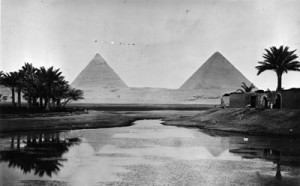
The similarity between the behavior of the Colorado and the Nile Rivers is a simple fact. Far more mysterious is the similarity between the creation myths of the Patayan, Mojave, Quechan and Hopi, and those of the ancient Egyptians, down to minute details in their stories and beliefs. Both rivers are said to be hung between a place of life and creation, and a land of death. Both are said to have been created and their directions set by specific deities; Mastamho in the case of the Colorado, and Hapi in the case of the Nile in Egypt. Both dieties are associated with fertility and north-south direction, and both rivers are related to sacred mountains or mounds, where both creation and divine oversight came from above.
So… are the scientific explanations for the origin and meaning simply all there is to the mystery of the Blythe Intaglios?

Or are they part of a cover-up intended to obscure an ancient, direct relationship between two places at opposite ends of the planet, possibly involving a visitation from Ancient Alien Astronauts whose stories remain forever inscribed into the deserts of the American southwest, and the temples of Egypt? We leave this question for you… and for Erich Von Daniken… to answer for yourselves!

